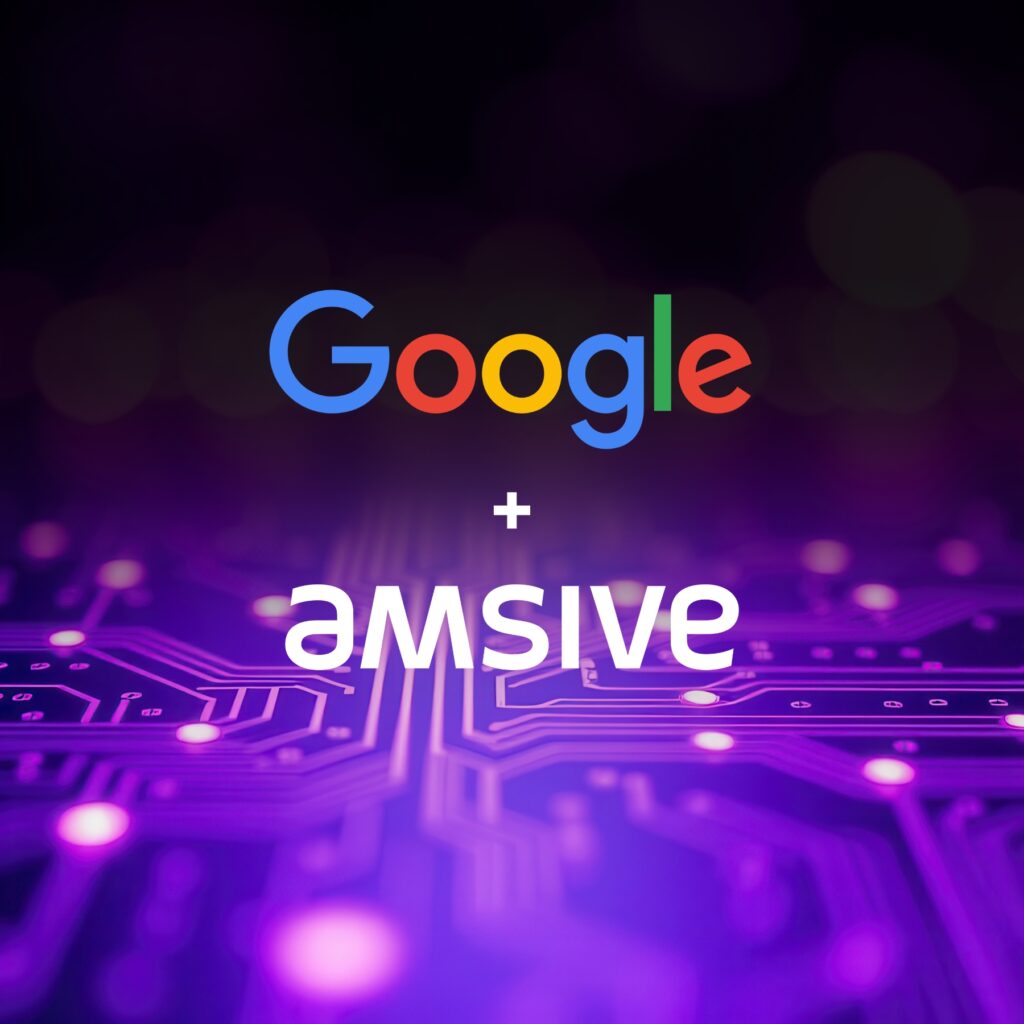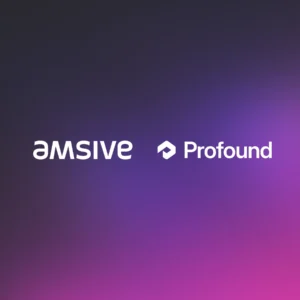About Google’s Helpful Content Update & Ranking System
Google first introduced the Helpful Content System & Ranking update on August 18, 2022. This update targeted low-quality content written primarily for search engines, not people. When the update was announced, Google also shared an article called “More content by people, for people in Search,” which explained why they were making these significant changes to their ranking systems.
According to Google, the purpose of the update was to ”introduce a new site-wide signal that we consider among many other signals for ranking web pages. Our systems automatically identify content that seems to have little value, low-added value or is otherwise not particularly helpful to those doing searches.” Google also indicated that the ranking system would target content that Google determined was created primarily for search engines, not for humans.
Jump To:
In an article outlining what creators should know about Google’s August 2022 helpful content update, the below points were emphasized:
- Ensure your content is valuable and useful to your audience and meets their needs if they were to visit your site directly.
- Demonstrate first-hand expertise and deep knowledge of the subject matter.
- Your site should have a clear primary purpose or focus.
- Make your content engaging and fulfilling, leaving readers with a positive impression of their visit.
- Follow the guidance for core updates and product reviews, ensuring your content meets the latest standards and recommendations.
- Avoid content that is written primarily for search engines and not for users, such as content that tries to earn lots of search traffic with overly optimized pages that may lack substantial value for human readers
The Helpful Content System also introduced a site-wide “classifier” applied to websites with significant unhelpful content, which could cause rankings to go down across many pages on the site. The classifier’s ranking impact was more severe depending on how much unhelpful content Google found on the site.
In September 2023, Google launched a major Helpful Content Update. This led to the extreme decline of many sites in various categories that lost upwards of 50% of their SEO visibility throughout the year.
Below is a slide from Lily Ray’s presentation about the Helpful Content Update from the Digital Marketer Organization conference in Napa in October 2023, which shows how many sites experienced a rapid increase in SEO visibility before being hit by the September 2023 Helpful Content Update:

Some of the key trends in the websites that showed this type of decline in September were:
- Excessive ads that disrupt the user experience, such as video auto-play ads and vignette ads
- Excessive affiliate links, often without substantial content to indicate that the site has truly reviewed the recommended products
- Insufficient E-E-A-T: sites often lacked named authors, any indication of author biographies, no evidence of a real staff or experts involved in the content creation process, AI-generated authors, etc.
- Excessive SEO-driven keyword patterns, such as using highly templated <title> tag patterns; excessive use of the year in the title, even when the content was not actually updated that year; excessive use of FAQs throughout the content without valuable or robust answers, etc.
- Too many low-quality product reviews: sites often included review content without true evidence of having used the product or visited the place being reviewed
- Too many low-quality pages: sites often contained many pages lacking true experience, expertise, or a unique perspective compared to other ranking pages on the same topic
- Stock photography or images taken from others’ social media accounts: many of the impacted sites used excessive stock photography and lacked original images that could help indicate that they truly experienced the place or product they were writing about. Other sites leveraged images taken from popular social media accounts, such as Instagram or Pinterest.
- Excessive AI-generated content strategies: although Google has claimed there is nothing inherently wrong with AI content and does not particularly care how the content was created, Google has also had long-standing policies against using excessive automation with little human oversight to create content. The heavy use of AI content appears to have been one of many contributing factors among the sites seeing the most significant declines.
Watch Lily Ray’s Video Analyzing What Happened with the Helpful Content Update
Google Incorporating Helpful Content Ranking System into Core Ranking Systems in March 2024
On Tuesday, March 5, 2024, Google announced a major, combination update to its algorithms: the March Core Update & March Spam Updates. The update “involves changes to multiple core systems and marks an evolution in how Google identifies the helpfulness of content.” As part of this update, Google deprecated the Helpful Content Ranking system – it is no longer a single system with a single classifier but has been incorporated into Google’s core ranking systems, which Google updated in March of 2024 in order to show helpful and satisfying content.
Google also added a new FAQ page specifically related to questions about the Helpful Content Update and its former ranking system. This FAQ helps explain that “their core ranking systems will now show more helpful results using a variety of innovative signals and approaches without using one signal or system to do this.”
Google also provides a list of self-assessment questions site owners can use to check the helpfulness of their content.
Another interesting development in this FAQ is how Google points out that its core ranking systems primarily assess content on a page-by-page basis but in some cases, also consider some site-wide signals. Google did not make clear which signals are looked at on the page-level vs. the site level.
It also outlines that while removing unhelpful content may improve the performance of your other pages in search results, there’s no fixed timeline for seeing potential ranking improvements after removing unhelpful content. Changes in ranking can happen gradually as Google’s systems process the updated content, so the timing of ranking improvements varies.
As of late March, there are no known significant recoveries among websites negatively impacted by the September Helpful Content Update, so as it stands, it is unclear how long this timeline for potential recovery will truly take.
Which Sites & Categories Felt the Biggest Impact from the Helpful Content Update?
Using the Sistrix Visibility Index, we have monitored approximately 400 sites affected by the September 2023 Helpful Content Update, and further negatively impacted by the March 2024 Core & Spam updates. This analysis helps us to identify common patterns, trends, and possible reasons for significant ranking declines across the sites.
Below are the categories we have identified as seeing many sites with major declines, plus some possible reasons for Google determining that their content is unhelpful.
Gaming
Among the sites we analyzed with the biggest ranking declines, many websites fell into the gaming category. In fact, several gaming websites appear to have received pure spam manual actions, which Google sent out as part of its spam update. For example, the gaming website in the screenshot below currently has no indexed pages on Google despite having received traffic and visibility up until March 8th (see the chart below).

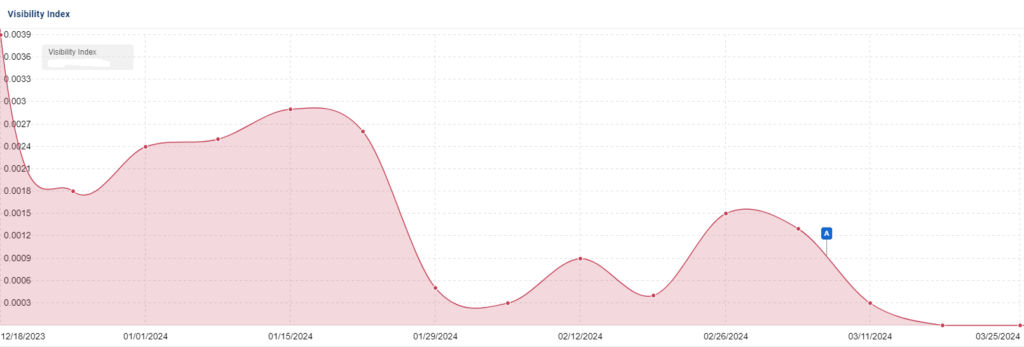
Other sites in this category had intrusive interstitials and disruptive ads that covered the main body of the pages.
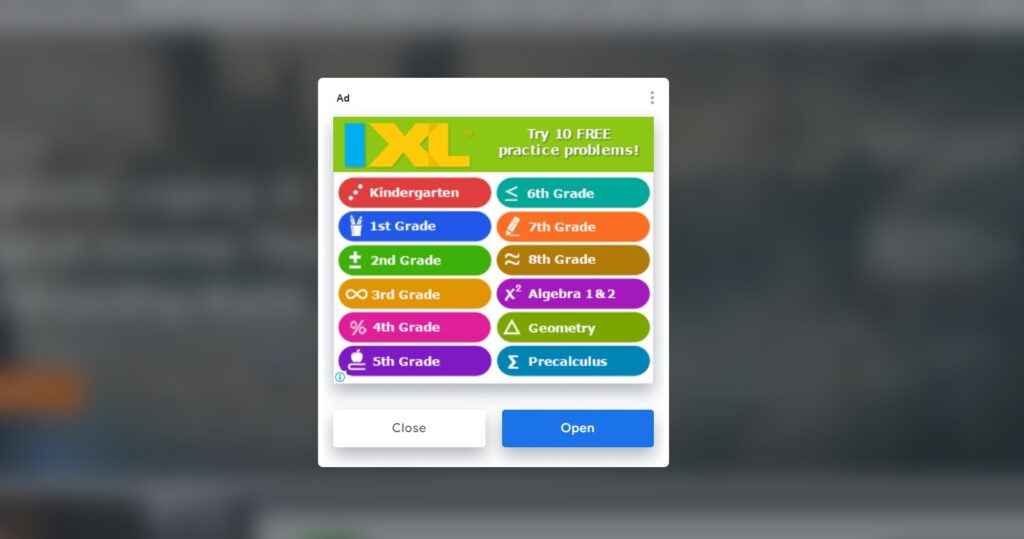
Analyzing a handful of these gaming sites revealed that many appeared to be using a “People Also Ask” question generator to address every possible question on the page topic, and provided low-quality answers, possibly to try and gain more visibility and clicks.
Some of the analyzed sites also had content that ventured into YMYL (your money, your life) topics, such as autism, where the sites do not have sufficient E-E-A-T (experience, expertise, authoritativeness, and trustworthiness) to provide trustworthy content on those topics. Google’s Quality Rater Guidelines provide specific guidance that Google considers pages that discuss YMYL topics without any evidence of E-E-A-T on those subjects to be the lowest quality pages.
Many websites that saw significant negative impacts from the Helpful Content Update and March Spam Updates contained significantly thin and low-quality content. Running blocks of content from these sites through Originality.ai revealed that much of their content was AI-generated. Some sites showed a score of 100% AI-generated content for some of their review articles.
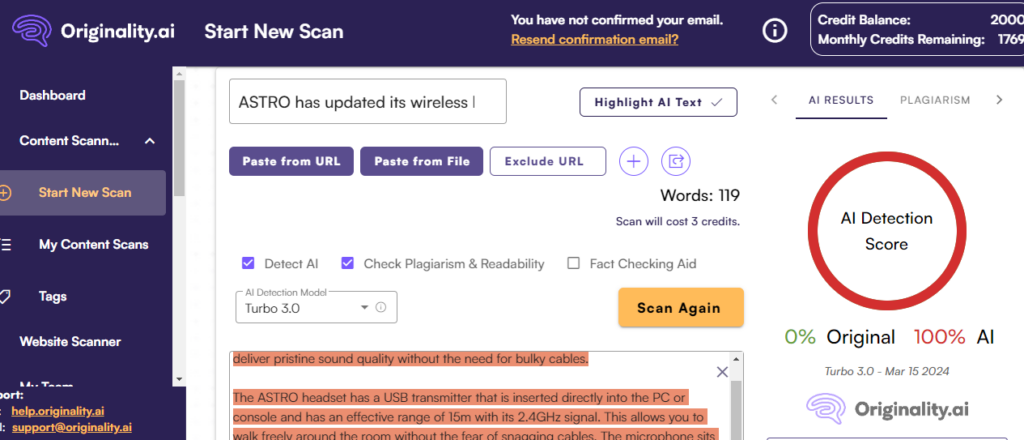
The chart below shows how some sites in this category steadily declined after the March Core/Spam update, leading to almost zero visibility. As you can see, the sites mostly saw significant visibility growth before that point, and several were also heavily impacted by the September Helpful Content Update.
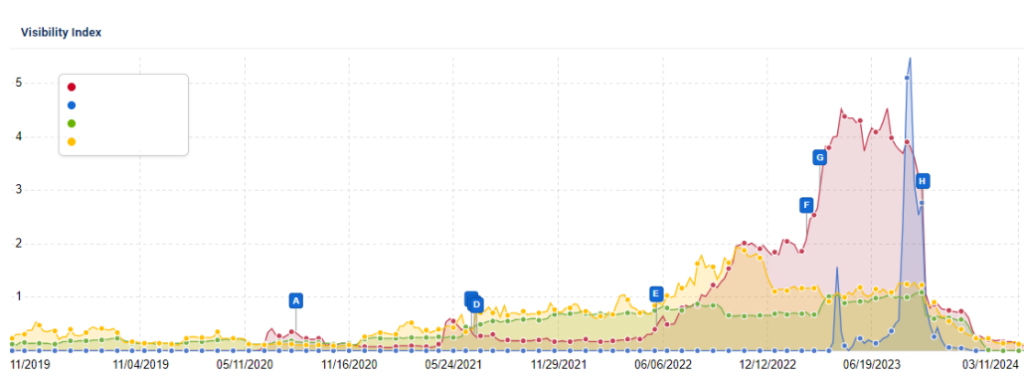
Niche blogs & product review sites
Many niche blogs and sites containing product reviews and affiliate links were hit by the March Core and Spam update, leading to a severe loss in visibility and rankings. Even worse, some websites got entirely deindexed via manual actions.
After researching, one common issue observed across niche affiliate websites affected by the update is the presence of intrusive ads and an excessive number of affiliate links, often with low-quality accompanying content. These ads disrupt the user experience, and users often find themselves bombarded with intrusive pop-ups and distractions, deviating from the value of the primary content.
Another significant issue observed in this category was using non-original imagery sourced from platforms like Pinterest or Instagram, a clear indicator that they had no evidence of having visited the mentioned destinations or provided the services mentioned.
The image below shows an image used by one of the websites using images from other sites, including TikTok, Pinterest, and Instagram.
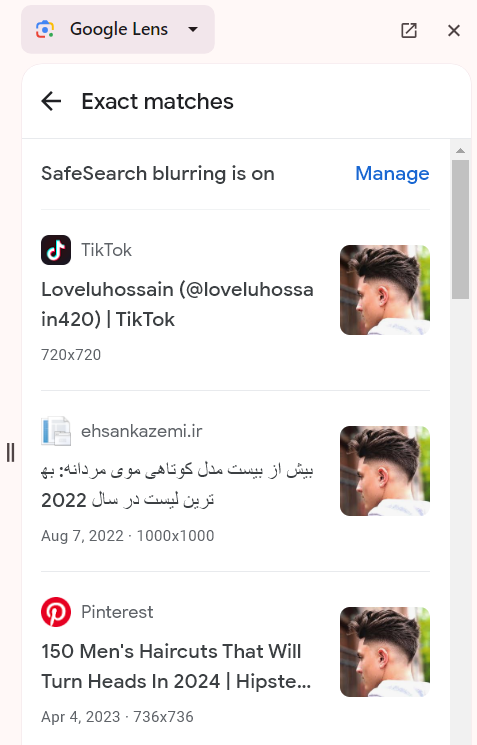
Also, some websites in this category received a score of 100% AI-generated content when assessing their content using originality.ai. This may have caused impacts by the March Spam update, due to its new language around mass-autogenerating content with little human oversight, also known as scaled content abuse.
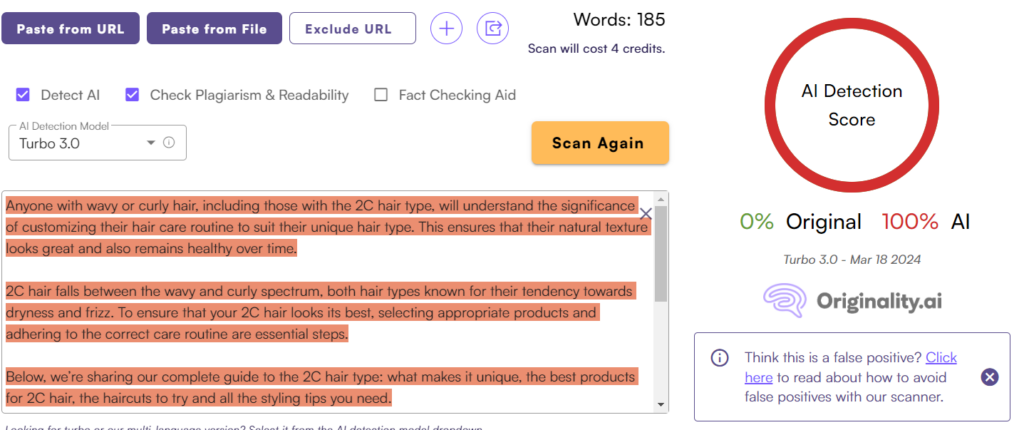
Some websites also covered a wide range of subjects, from purchasing bicycles to exercise tips and even celebrity hairstyles like Justin Bieber’s latest cuts. This lack of niche specialization could be an indicator to Google that the site lacks expertise, hindering the website’s perception as a reliable source within the niche.
Other sites in this category received an originality.ai score of 100% AI content across large swaths of their content, including their customer reviews. The use of unedited, unnatural AI content is a clear indication that no human intervention was made to demonstrate expertise and experience. Google is clear about its guidelines for better ranking of original, quality content to reduce low-quality content and make it easier to find content that feels authentic and useful in search.
After analyzing the search results, some sites in this category seemed to use excessive keyword stuffing and focused too heavily on one long-tail keyword for each page. In many cases, it would have been a better experience for the user to have multiple similar topics consolidated onto one helpful page. The content quality was likely compromised, as the primary focus became incorporating keywords rather than providing valuable information to users, as seen in the image below.

Other websites were also seen covering topics related to personal information about celebrities without evidence, demonstrating a lack of expertise and failing to establish themselves as authoritative sources. This approach may have significantly lowered their site’s perceived helpfulness and overall E-E-A-T.
MP3 Downloads, Ringtones, Lyrics & More
Just like the categories we’ve covered so far, this category had many articles containing AI-generated content with scores of up to 100% using Originality.ai.
Another factor that may have affected this category is the fact that many music downloader and lyrics sites had no main content at all, other than titles and music/ringtone embeds with no added context or information. The sites feature confusing navigation, poor, dated UX, and some websites have created one page per ringtone or mp3, which could be considered excessive. Furthermore, the user experience feels deceptive, as there are often multiple download buttons, and several of them lead to advertisements or spam.
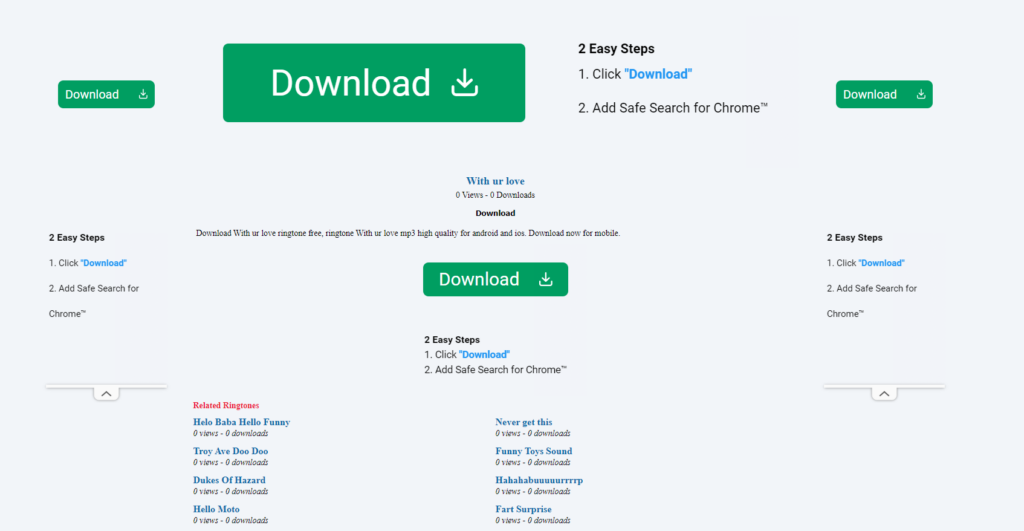
There are other aggressive calls to action to download on most of these sites. The download option also comes with a file that one should install on their computer, something many users would be reluctant to do or could install dangerous software on their computers. Google also references these tactics as the lowest quality pages in its Search Quality Guidelines.
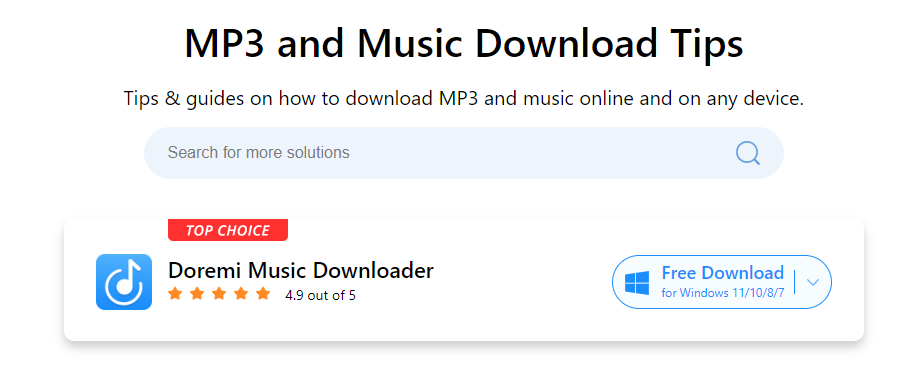
Though it appears that many of these sites are actively making changes to their sites, several are also attempting to artificially update dates in order to use “2024” in the title, despite being last updated in 2023 or earlier. This is a tactic listed in Google’s News and Discover manual actions referred to as “artificial refreshening,” and it was common among many websites hit by both the Helpful Content Update and the March Spam Updates.
Some websites in this category also had some of their pages taken down due to copyright infringement, as shown below.

Most sites had confusing navigation, a poor user experience, and aggressive advertisements.
As with similar categories, many of the sites also featured articles answering every possible question using a Q&A style. The answers provided were short with not much value, probably an indicator that they were leveraging an SEO keyword research tool to generate questions, then a generative AI tool to generate low-quality, unhelpful answers to those questions.
A site: search also revealed that many sites in this category seemed to be focused on using longtail keywords for ranking purposes, meaning more focus on driving traffic rather than providing value to users, as shown in the image below.
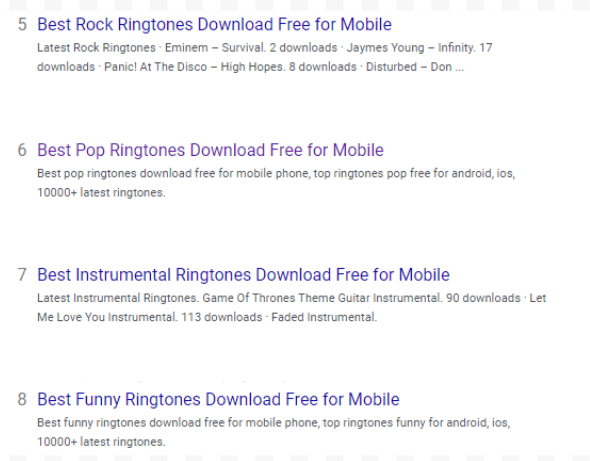
A more recent site search of the site in the image above reveals that it’s up for sale as shown in the below image. This is common for many sites that are significantly impacted by Google’s algorithm updates or removed via a manual action – it might not be worth the effort to maintain the site afterward.
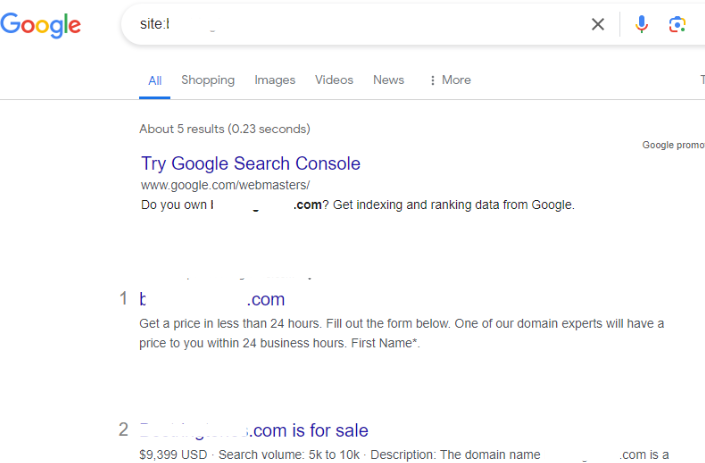
Some of these websites covered unrelated content, including everything from TV apps and iPhone widgets to Instagram models, seemingly to gain more traffic to the site wherever SEO opportunity existed. This content showed no expertise or experience and lacked author names and/or biographies. The problem with this type of content is that Google probably doesn’t know where to place them as a value provider, which could be the reason why the update had such a huge negative effect on this category.
Travel
Many websites in the “travel” category also suffered a great hit from the March 2023 Core & Spam Updates. While several of the worst-affected websites provided travel guidance with little to no evidence that the author had ever visited the destination, this is a category where many sites that did, in fact, provide first-hand travel experience also felt major impacts.
Among the travel sites seeing 90%+ drops in visibility, AI-generated content stood out the most. Some sites in this category scored as high as 91% AI-generated content, as shown below.
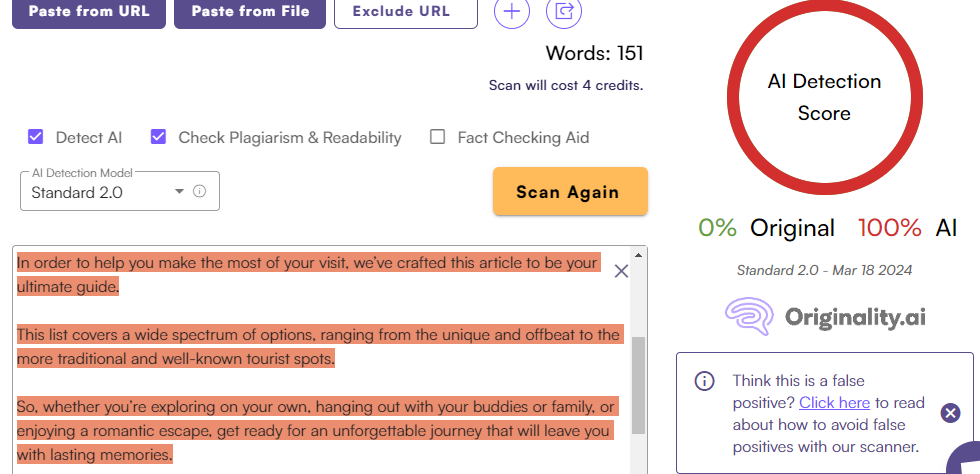
Another probable cause for the effects of the update to this category was the use of generic stock photography instead of real photos of the destinations. Those that were original were credited to someone else, indicating that the authors hadn’t visited these destinations.
In the chart below, note how every one of these 4 sites saw substantial visibility declines during the September 2023 Helpful Content Update. This could indicate that many of the same issues that caused declines in September might also be at play with Google’s March 2023 Core & Spam Updates.

Many of these travel sites have overly aggressive advertising and/or affiliate links, distracting or making it hard to access the main content or causing the recommendations and advice to appear slightly biased. In some cases, the articles would contain generic affiliate links to products that could be used for travel anywhere, despite the content targeting a specific city or region.
Many of the travel sites featured thin content that didn’t quite provide as much information as they could have, to be deemed helpful. For example, the sites may have created one page with things to do in every city in the entire United States, using generic information from Google Maps, TripAdvisor, or Yelp to produce the recommendations without original insights or experience. Some of the topics covered also seemed to be focused more on driving traffic than providing value to users, as shown in the slide below:
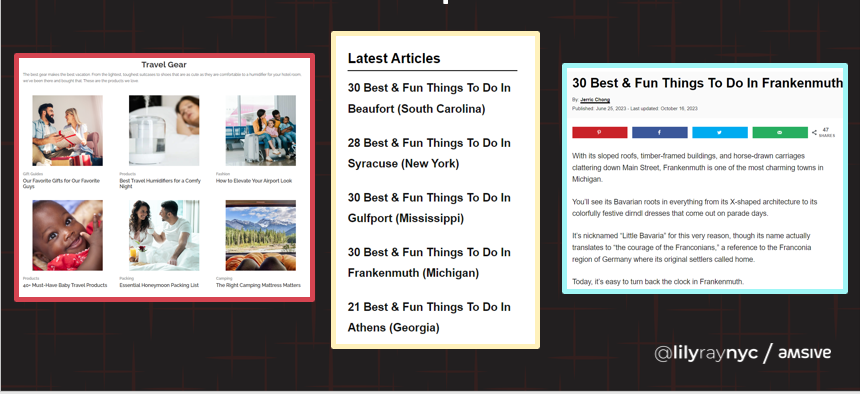
There were also many artificially edited dates, such as the below article which uses 2024 in the title, despite being last updated in 2023 or earlier.

The below slide shows a summary of what may have caused issues for many travel sites during the Helpful Content Update and March Core/Spam updates:
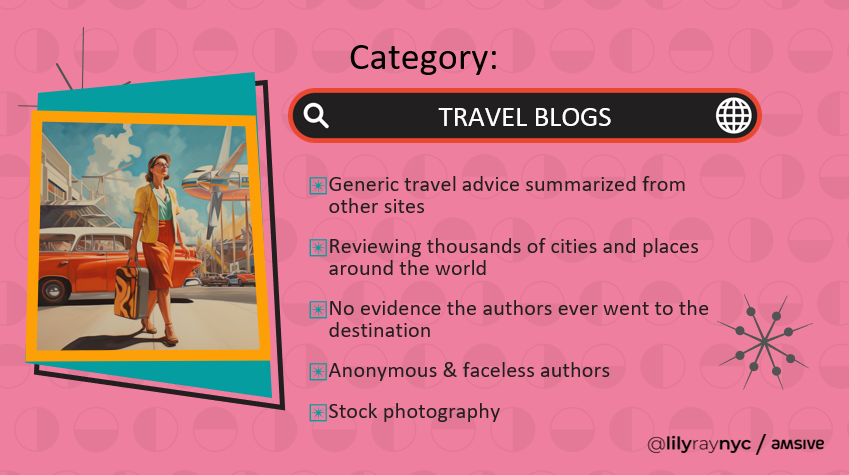
Unfortunately, this category seems to have caused significant collateral damage, as many legitimate travel bloggers who did indeed visit the destinations they reviewed also saw substantial traffic declines stemming from these updates. Time will tell whether Google makes adjustments to its ranking systems to ensure travel bloggers with real experience are able to receive more organic search traffic.
Information & Research
The information and research category included online tools and data, such as calculators, converters, city data, and other aggregated data. This category saw a huge decline in visibility after the new March 2024 Core & Spam updates. The chart below shows the trajectory of one site in this category, which was common among many sites affected by both the September Helpful Content Update and March Core / Spam Updates:
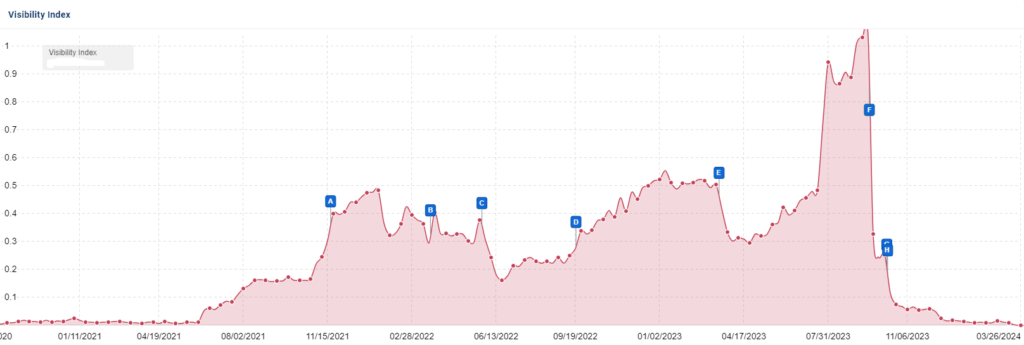
Like many other affected sites, some sites in this category attempted to have one page per question in a way that perfectly matches how searchers look for these questions, using publicly available data to answer the question without adding much other original value.

Some of the sites showed an AI detection score of 100%, which could be why they had some of their pages, site sections, or entire sites deindexed.
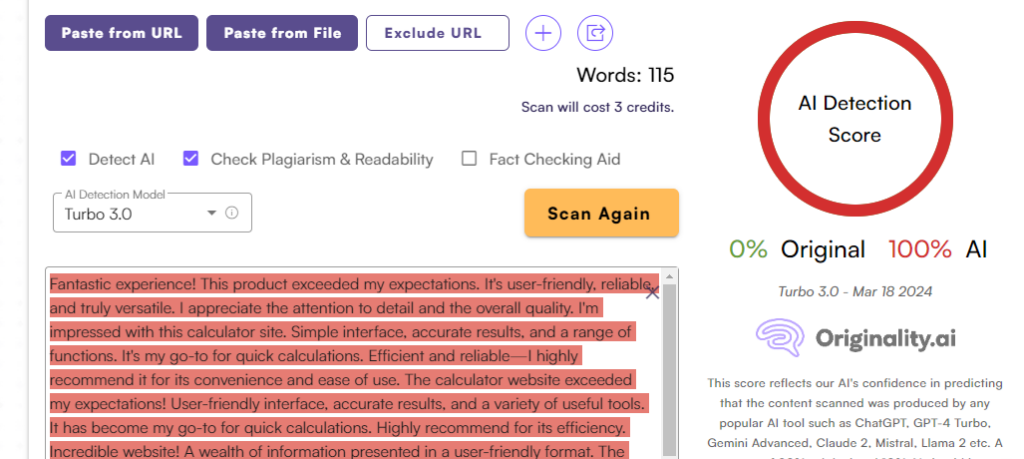
Looking at a few sites in this category, the chart below shows a uniform decline in visibility right after the September Helpful Content Update. This decline continued steadily, and after the March 2024 Updates, Indicated by the letter ‘Q’, visibility has gone down to zero or nearly zero for some sites.

All in all, a poor user experience, excessive overly-optimized pages, and slow load time for images, as well as excessive AI-generated content seemed to play a pivotal role in visibility decline for most sites in this category.
Technology and Software
Some websites in the Technology and Software category were significantly hit by the March 2024 core and spam update where most websites saw a significant loss in visibility, as seen in the image below. Many of these sites reviewed VPNs, digital security, privacy software, and more.
One of the biggest losers of the September Helpful Content Update in this category appears to have received a pure spam manual action during the March Core Update, as its pages have been entirely removed from Google’s index despite still appearing on Bing. The entire purpose of this site appears to be getting the user to click its VPN affiliate links.
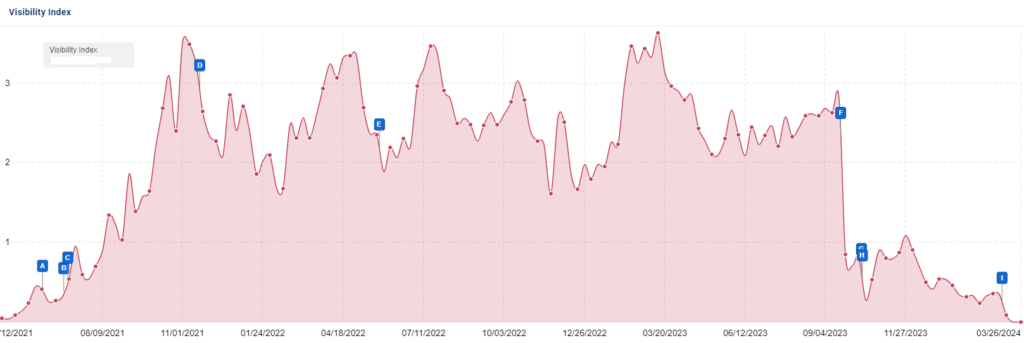
Also, some websites in this category are seen to have software recommendations or download buttons (shown in the image below) that redirect automatically to the affiliate website and automatically download the software onto users’ PCs upon clicking. Clicking on then leads to unintended consequences such as downloading malware, viruses, or unwanted software. As stated throughout Google’s search quality & web spam guidelines, this results in decreased transparency, trust, and a poor user experience.
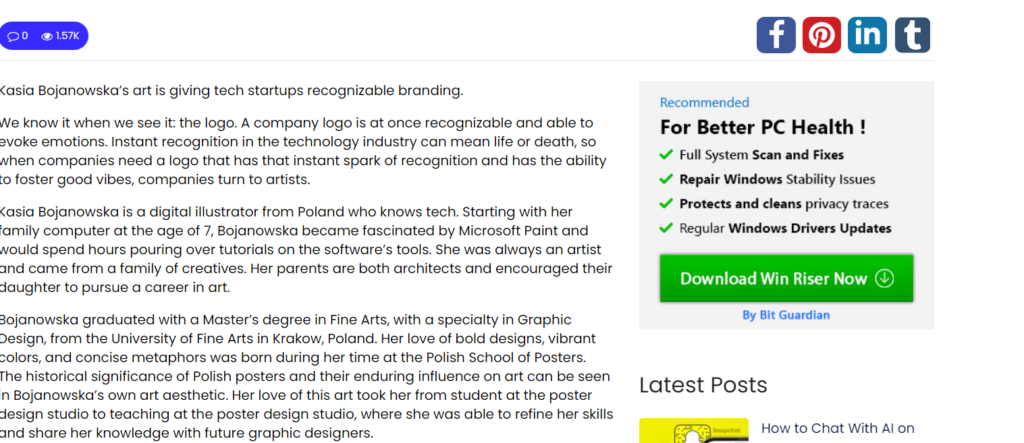
Some of the blogs on the websites in this category lacked author names or evidence of real human involvement, like in the image shown below. The blog’s lack of transparency might have made it difficult for Google and searchers to assess the credibility and expertise of the content creators.
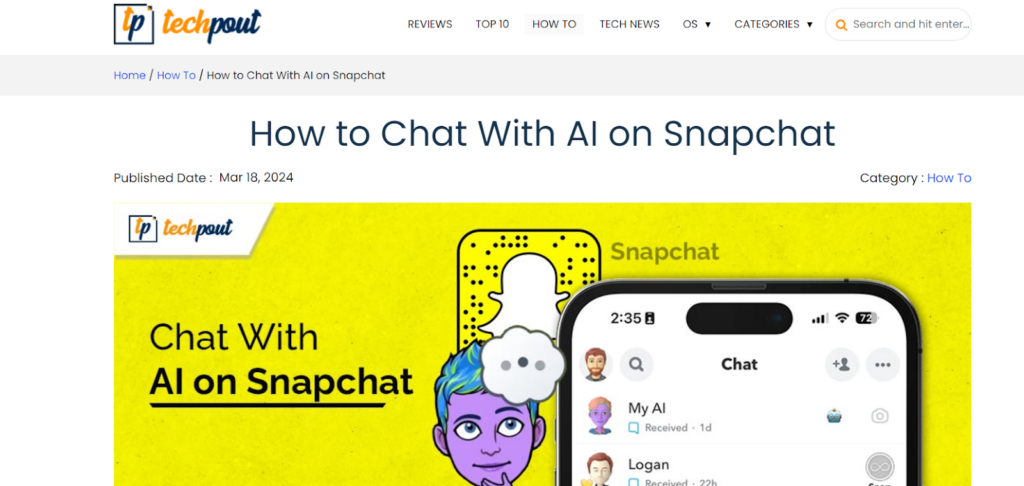
Also, many websites in this category had annoying ads in the form of excessive pop-ups, autoplay video ads with sound, and layouts dominated by banner ads.
Also, some affiliate websites in this category covered all possible topics in the category niche, always with the same call to action, promoting the affiliate VPN.
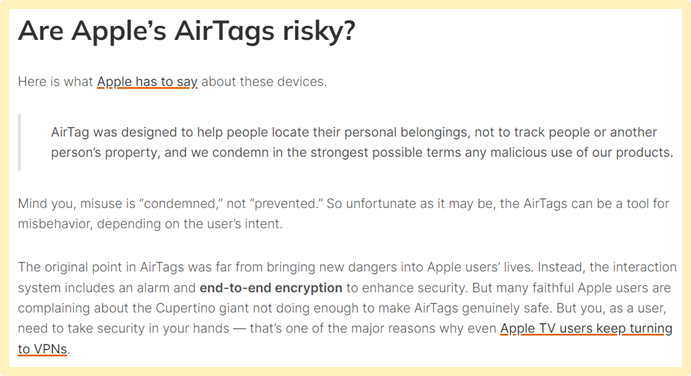
Websites within this category are seen to use unoriginal images sourced from other websites like eBay and Walmart, as indicated by Google Lens. Google values fresh, unique and relevant images, and the excessive use of unoriginal photography may have been a contributing factor for sites being impacted by the Helpful Content Update and subsequent updates.
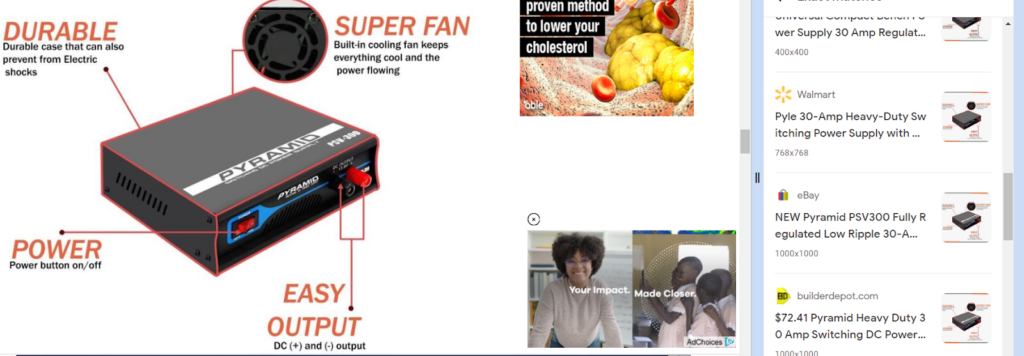
Looking Ahead
In March of 2024, Google incorporated what was previously the Helpful Content ranking system into its core ranking systems, and now uses a variety of signals to determine overall website helpfulness. Many sites that were significantly impacted by the September 2023 Helpful Content Update have seen a substantial decrease in traffic and visibility resulting from Google’s March 2024 updates. While the update has yet to finish rolling out, and it’s possible that Google will make adjustments to its algorithms that may benefit some of these sites, so far, there have been no notable recoveries from the major impacts felt by websites hit by Google’s notorious September Helpful Content Update.
Stay tuned for future updates to this article, and further insights on Google’s Helpful Content Ranking system.
Learn about the winners, losers, and overall trends across SEO in 2023, or, let’s talk about how to achieve more for your marketing—and your business.
